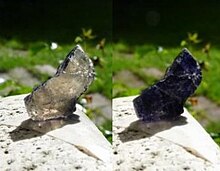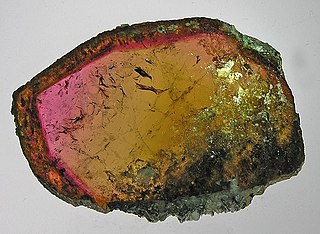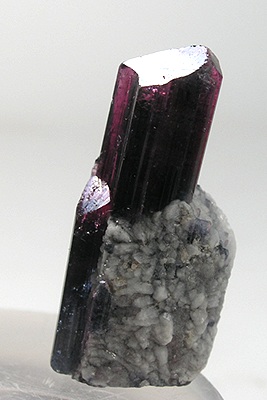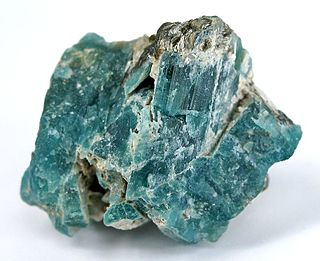

Pleochroism is an optical phenomenon in which a substance has different colors when observed at different angles, especially with polarized light. [1]


Pleochroism is an optical phenomenon in which a substance has different colors when observed at different angles, especially with polarized light. [1]
The roots of the word are from Greek (from Ancient Greek πλέων (pléōn) 'more',and and χρῶμα (khrôma) 'color'). It was first made compound in the German term Pleochroismus by mineralogist Wilhelm Haidinger in 1854, in the journal Annalen der Physik und Chemie. [2] Its first known English usage is by geologist James Dana in 1854. [3]
Anisotropic crystals will have optical properties that vary with the direction of light. The direction of the electric field determines the polarization of light, and crystals will respond in different ways if this angle is changed. These kinds of crystals have one or two optical axes. If absorption of light varies with the angle relative to the optical axis in a crystal then pleochroism results. [4]
Anisotropic crystals have double refraction of light where light of different polarizations is bent different amounts by the crystal, and therefore follows different paths through the crystal. The components of a divided light beam follow different paths within the mineral and travel at different speeds. When the mineral is observed at some angle, light following some combination of paths and polarizations will be present, each of which will have had light of different colors absorbed. At another angle, the light passing through the crystal will be composed of another combination of light paths and polarizations, each with their own color. The light passing through the mineral will therefore have different colors when it is viewed from different angles, making the stone seem to be of different colors.
Tetragonal, trigonal, and hexagonal minerals can only show two colors and are called dichroic. Orthorhombic, monoclinic, and triclinic crystals can show three and are trichroic. For example, hypersthene, which has two optical axes, can have a red, yellow, or blue appearance when oriented in three different ways in three-dimensional space. [5] Isometric minerals cannot exhibit pleochroism. [1] [6] Tourmaline is notable for exhibiting strong pleochroism. Gems are sometimes cut and set either to display pleochroism or to hide it, depending on the colors and their attractiveness.
The pleochroic colors are at their maximum when light is polarized parallel with a principal optical vector. The axes are designated X, Y, and Z for direction, and alpha, beta, and gamma in magnitude of the refractive index. These axes can be determined from the appearance of a crystal in a conoscopic interference pattern. Where there are two optical axes, the acute bisectrix of the axes gives Z for positive minerals and X for negative minerals and the obtuse bisectrix gives the alternative axis (X or Z). Perpendicular to these is the Y axis. The color is measured with the polarization parallel to each direction. An absorption formula records the amount of absorption parallel to each axis in the form of X < Y < Z with the left most having the least absorption and the rightmost the most. [7]
Pleochroism is an extremely useful tool in mineralogy and gemology for mineral and gem identification, since the number of colors visible from different angles can identify the possible crystalline structure of a gemstone or mineral and therefore help to classify it. Minerals that are otherwise very similar often have very different pleochroic color schemes. In such cases, a thin section of the mineral is used and examined under polarized transmitted light with a petrographic microscope. Another device using this property to identify minerals is the dichroscope. [8]

A gemstone is a piece of mineral crystal which, when cut or polished, is used to make jewelry or other adornments. Certain rocks and occasionally organic materials that are not minerals may also be used for jewelry and are therefore often considered to be gemstones as well. Most gemstones are hard, but some softer minerals such as brazilianite may be used in jewelry because of their color or luster or other physical properties that have aesthetic value. However, generally speaking, soft minerals are not typically used as gemstones by virtue of their brittleness and lack of durability.

Sapphire is a precious gemstone, a variety of the mineral corundum, consisting of aluminium oxide (α-Al2O3) with trace amounts of elements such as iron, titanium, cobalt, lead, chromium, vanadium, magnesium, boron, and silicon. The name sapphire is derived from the Latin word sapphirus, itself from the Greek word sappheiros (σάπφειρος), which referred to lapis lazuli. It is typically blue, but natural "fancy" sapphires also occur in yellow, purple, orange, and green colors; "parti sapphires" show two or more colors. Red corundum stones also occur, but are called rubies rather than sapphires. Pink-colored corundum may be classified either as ruby or sapphire depending on locale. Commonly, natural sapphires are cut and polished into gemstones and worn in jewelry. They also may be created synthetically in laboratories for industrial or decorative purposes in large crystal boules. Because of the remarkable hardness of sapphires – 9 on the Mohs scale (the third hardest mineral, after diamond at 10 and moissanite at 9.5) – sapphires are also used in some non-ornamental applications, such as infrared optical components, high-durability windows, wristwatch crystals and movement bearings, and very thin electronic wafers, which are used as the insulating substrates of special-purpose solid-state electronics such as integrated circuits and GaN-based blue LEDs. Sapphire is the birthstone for September and the gem of the 45th anniversary. A sapphire jubilee occurs after 65 years.

Tourmaline is a crystalline silicate mineral group in which boron is compounded with elements such as aluminium, iron, magnesium, sodium, lithium, or potassium. This gemstone comes in a wide variety of colors.

The mineral or gemstone chrysoberyl is an aluminate of beryllium with the formula BeAl2O4. The name chrysoberyl is derived from the Greek words χρυσός chrysos and βήρυλλος beryllos, meaning "a gold-white spar". Despite the similarity of their names, chrysoberyl and beryl are two completely different gemstones, although they both contain beryllium. Chrysoberyl is the third-hardest frequently encountered natural gemstone and lies at 8.5 on the Mohs scale of mineral hardness, between corundum (9) and topaz (8).

In optics, a dichroic material is either one which causes visible light to be split up into distinct beams of different wavelengths (colours), or one in which light rays having different polarizations are absorbed by different amounts.
Lustre or luster is the way light interacts with the surface of a crystal, rock, or mineral. The word traces its origins back to the Latin lux, meaning "light", and generally implies radiance, gloss, or brilliance.

Epidote is a calcium aluminium iron sorosilicate mineral.

Vivianite (Fe2+
3(PO
4)
2·8H
2O) is a hydrated iron phosphate mineral found in a number of geological environments. Small amounts of manganese Mn2+, magnesium Mg2+, and calcium Ca2+ may substitute for iron Fe2+ in the structure. Pure vivianite is colorless, but the mineral oxidizes very easily, changing the color, and it is usually found as deep blue to deep bluish green prismatic to flattened crystals. Vivianite crystals are often found inside fossil shells, such as those of bivalves and gastropods, or attached to fossil bone. Vivianite can also appear on the iron coffins or on the corpses of humans as a result of a chemical reaction of the decomposing body with the iron enclosure.

A chemically pure and structurally perfect diamond is perfectly transparent with no hue, or color. However, in reality almost no gem-sized natural diamonds are absolutely perfect. The color of a diamond may be affected by chemical impurities and/or structural defects in the crystal lattice. Depending on the hue and intensity of a diamond's coloration, a diamond's color can either detract from or enhance its value. For example, most white diamonds are discounted in price when more yellow hue is detectable, while intense pink diamonds or blue diamonds can be dramatically more valuable. Of all colored diamonds, red diamonds are the rarest. The Aurora Pyramid of Hope displays a spectacular array of naturally colored diamonds, including red diamonds.

A diamond simulant, diamond imitation or imitation diamond is an object or material with gemological characteristics similar to those of a diamond. Simulants are distinct from synthetic diamonds, which are actual diamonds exhibiting the same material properties as natural diamonds. Enhanced diamonds are also excluded from this definition. A diamond simulant may be artificial, natural, or in some cases a combination thereof. While their material properties depart markedly from those of diamond, simulants have certain desired characteristics—such as dispersion and hardness—which lend themselves to imitation. Trained gemologists with appropriate equipment are able to distinguish natural and synthetic diamonds from all diamond simulants, primarily by visual inspection.

Vauxite is a phosphate mineral with the chemical formula Fe2+Al2(PO4)2(OH)2·6(H2O). It belongs to the laueite – paravauxite group, paravauxite subgroup, although Mindat puts it as a member of the vantasselite Al4(PO4)3(OH)3·9H2O group. There is no similarity in structure between vauxite and paravauxite Fe2+Al2(PO4)2(OH)2·8H2O or metavauxite Fe3+Al2(PO4)2(OH)2·8H2O, even though they are closely similar chemically and all minerals occur together as secondary minerals. Vauxite was named in 1922 for George Vaux Junior (1863–1927), an American attorney and mineral collector.

Optical mineralogy is the study of minerals and rocks by measuring their optical properties. Most commonly, rock and mineral samples are prepared as thin sections or grain mounts for study in the laboratory with a petrographic microscope. Optical mineralogy is used to identify the mineralogical composition of geological materials in order to help reveal their origin and evolution.
Diamond type is a method of scientifically classifying diamonds by the level and type of their chemical impurities. Diamonds are separated into five types: Type IaA, Type IaB, Type Ib, Type IIa, and Type IIb. The impurities measured are at the atomic level within the crystal lattice of carbon atoms and so, unlike inclusions, require an infrared spectrometer to detect.

Jeremejevite is an aluminium borate mineral with variable fluoride and hydroxide ions. Its chemical formula is Al6B5O15(F,OH)3. It is considered as one of the rarest, thus one of the most expensive stones. For nearly a century, it was considered as one of the rarest gemstones in the world.

Fluor-liddicoatite is a rare member of the tourmaline group of minerals, elbaite subgroup, and the theoretical calcium endmember of the elbaite-fluor-liddicoatite series; the pure end-member has not yet been found in nature. Fluor-liddicoatite is indistinguishable from elbaite by X-ray diffraction techniques. It forms a series with elbaite and probably also with olenite. Liddiocoatite is currently a non-approved mineral name, but Aurisicchio et al. (1999) and Breaks et al. (2008) found OH-dominant species. Formulae are

Fluor-uvite is a tourmaline mineral with the chemical formula CaMg3(Al5Mg)(Si6O18)(BO3)3(OH)3F. It is a rare mineral that is found in calcium rich contact metamorphic rocks with increased amounts of boron. Uvite is trigonal hexagonal, which means that it has three equal length axes at 120 degrees, all perpendicular to its fourth axis which has a different length. Uvite is part of the space group 3m. Uvite's hardness has been measured to be 7.5 on the Mohs hardness scale. The color of uvite widely varies, depending on the sample, but is mostly deep green or brown. In regard to uvite's optical properties, it is uniaxial (-) and anisotropic, meaning that the velocity of light in the mineral depends on the path that it takes. In plane polarized light, uvite is colorless to pale yellow and shows weak pleochroism.

Magnesiohastingsite is a calcium-containing amphibole and a member of the hornblende group. It is an inosilicate (chain silicate) with the formula NaCa2(Mg4Fe3+)(Si6Al2)O22(OH)2 and molar mass 864.69 g. In synthetic magnesiohastingsite it appears that iron occurs both as ferrous iron Fe2+ and as ferric iron Fe3+, but the ideal formula features only ferric iron. It was named in 1928 by Marland P. Billings. The name is for its relationship to hastingsite and its magnesium content. Hastingsite was named for the locality in Dungannon Township, Hastings County, Ontario, Canada.

Grandidierite is a rare mineral that was first discovered in 1902 in southern Madagascar. The mineral was named in honor of French explorer Alfred Grandidier (1836–1912) who studied the natural history of Madagascar.
The Mount Simon Sandstone is an Upper Cambrian sandstone and is found in many states in the Midwest such as Wisconsin, Minnesota, Iowa, Illinois, Iowa, and Missouri.